For just a minute, imagine you are a dog, a predator animal, with thousands of years of selective breeding to gaze upon the horizon and chase anything that moves. Let yourself feel the anticipation of that initial sighting and the blast of adrenalin as you take off and tear up the ground between you and your prey. Your front feet and your rear feet meet under your body as you coil tightly before exploding into full stride. As you hit top speed, your stride lengthens, enabling you to run 30-plus miles per hour. There is nothing you would rather be doing. The world outside your chase ceases to exist. You are in your element.
Jim Wallace
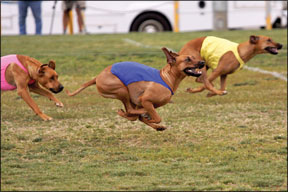
This is lure coursing.
You don’t need to be a sighthound to experience the thrills of a good chase, but if you are, you are built for speed off the start line, resilience to overheating, and a reluctance to give up the chase. If you are a terrier with similar predatory instincts, you’ll do fine as well. If you are a bit on the bigger, heavier side, you might enjoy the chase just as much, but you’ll be slower and tire more quickly.
Regardless of your size and structure, if you like to chase things that move, you’ll love lure coursing.
The Game of Lure Coursing
The lure is either a bit of fleecy material or a plastic grocery bag. It is tied to a line (often double-braided fishing line) that is wound around a number of pulleys. The pulleys are motorized by starter motors and car batteries. The operator of the pulley makes sure that the lure moves fast enough ahead of the dog to incite chase, but not too fast so the beginner dog can’t see it and stay motivated to chase. In competition lure coursing, pulley speeds of up to 40 miles per hour are used. Those sighthounds can run!
Often standing on a ladder, to afford a good view of the entire course, the lure operator moves the line with the lure into place ahead of the start line. Dogs are held at the start line, many of them straining, yelping, and barking to be let go. As the pulley whips the lure ahead, the dogs are released for the chase.
In competition lure coursing, the “course” can cover between 600 and 1,000 yards, and the lure takes several sharp turns to simulate the changes of direction a jack rabbit might take.
Dogs are scored for speed, agility, endurance, enthusiasm, and “following” (as opposed to taking short cuts across the field). There is also a limited amount of time for the handler to get control of his dog at the end of the course. At one lure coursing competition I observed, it took about six people and several minutes to convince a young Basenji to return to his handler. This can be dangerous as well as slow down the smooth running of a trial, so points are deducted.
In recreational coursing, there may be speed bumps and low tire jumps to hurdle, as well as several changes of direction. The first run for many dogs is pretty fast, but it’s the second run that shows how they’ve figured out the game. My 10-pound Rat Terrier, Pretzel, clocked in at 22 seconds in her first try at lure coursing, but her second race was 12 seconds. She had learned how to cut yardage off the corners, or turns.
Most lure coursing competitions race two or three dogs against each other, sometimes all of the same breed (Ridgebacks competing against other Ridgies), sometimes of different breeds. So how do you tell who is who in the blur of racing dogs? Each dog wears a brightly colored “coursing blanket.” These are light-weight, brightly colored shells, each color assigned before each run.
This is a highly arousing sport; however, it is unusual for dogs to stop racing and fight with each other. Part of this is early training, but it’s also partly a result of genetics; sighthounds were bred to run in groups after prey. A handler can choose, however, to run her dog in a muzzle if she has any concern about her dog displaying aggressive behaviors at another dog.
Photo Courtesy of The Author
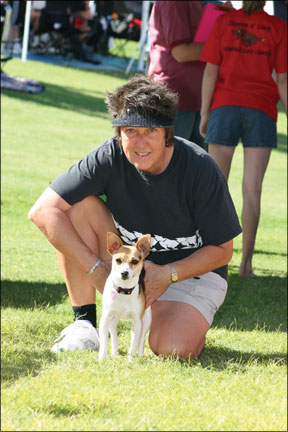
To help avoid undue competition for a single lure, there are three lures placed several feet apart along the pulley line.
Chasing Away the Fears
Verial Whitten contacted me when she was looking for professional help for her Saluki, Reah (pronounced ray-uh). A long-time Saluki owner living in San Clemente, California,
Verial had several Salukis before Reah, who was found as a stray and brought to a rescue organization. Verial Whitten and Barbara Nackerud adopted Reah in 2008. Reah got along fine with Verial’s young male Saluki, but would raise her hackles, snarl, bark, and lunge at dogs she encountered on walks.
Over the course of several months, Verial learned how to convince Reah that the presence of other dogs was not a threat. As a result, both Reah and Verial became more relaxed around other dogs on-leash, learning how to accept the approach of other dogs. During this time, Reah was also introduced to carefully selected dogs off-leash; she surprised Verial by attempting to solicit play from one of them.
Verial remembers Reah’s progression from a timid, reactive dog unlikely to be able to participate in the sport Verial knew she would love:
“When I realized how reactive Reah was when she simply saw another dog, I didn’t even consider lure coursing, although I had enjoyed the sport with my other Salukis. Reah’s behavior around other dogs made walking her unpleasant and stressful.
“We learned positive methods for decreasing her reactivity. I learned to watch for earlier cues from her that she was uncomfortable around other dogs, instead of waiting for her
to growl or lunge. That way, I could signal her earlier to offer an alternative behavior, such as sit, as the other dog passed by. With repetition, she relaxed more at the sight of dogs.
“Without working through her issues to find appropriate ways to deal with her fear of other dogs, we would not be having the fun that we do now, competing at lure coursing You can ask anyone who saw us at the first luring events I brought her to about the changes they saw in Reah. In the beginning, she would press herself against me around other dogs and vocalize from the safety of my car. She was best initially with other Salukis (never overly friendly, just okay), then okay with Whippets, but the larger breeds, especially Rhodesian Ridgebacks, were very unnerving for her. What helped was she really loved running the lure.
“She ran alone for her Junior Courser title and then participated in three other trials as the pilot dog (who runs the course alone before the start of scoring to make sure the course doesn’t need adjustments). Then I ran her with one Saluki who had been in her foster home. At that owner’s advice, we let the other Saluki leave the line first to evaluate how Reah would be passing a dog. That went well and then they ran stride for stride without incident.
“Since then, Reah has competed in three trials. has two Best of Breeds, and one Best in Field. In her first BIF, she ran with a Ridgeback, and when she won, she was with a Pharaoh Hound and a Borzoi, She is focused on the lure, untroubled by the other dogs, and smiling the whole time she is running.
“On walks, she is less troubled by other dogs. As for me, initially, I did keep her on a short, tight leash and would have to make myself loosen up so that my own anxiety did not increase hers. As she relaxed, so did I!”
History of Lure Coursing
Lure coursing has been around for thousands of years since hounds were used to find prey not by scent, but by sight. Egyptian tombs from 4,000 years ago contain paintings of long-legged hounds chasing prey. These kinds of hounds were selectively bred for both speed and “gaze” and were used to kill small game such as rabbits.
The oldest U.S. organization to sponsor competition is the American Sighthound Field Assocation (ASFA), which was officially launched in 1972. The American Kennel Club (AKC) established their standards for competition in 1991. A new organization, the National Lure Coursing Club, had its inaugural race in January of this year.
These organizations specify which sighthounds can compete in their events. They typically include Afghans, Basenjis, Borzois, Greyhounds, Ibizans, Irish Wolfhounds, Italian Greyhounds, Pharaoh Hounds, Rhodesian Ridgebacks, Salukis, Scottish Deerhounds, and Whippets.
Recreational and/or “all breeds” lure coursing events are also available, but are less common than sighthound-only events. Recreational lure coursing events encourage all breeds and all mixes to participate, and events are usually held in conjunction with another dog-related event.
Lure Coursers’ Attributes
Lure coursing is a demanding sport. The course, whether it is for competition or recreation, requires dogs to turn abruptly and sharply. This can put a lot of pressure on a dog’s knees – especially dogs who are, let’s say, pleasantly plump. The more fit a dog is, the less pressure is placed on joints. Some dogs with short noses (the bracycephalic breeds such as pugs, French bulldogs, etc.) must be watched for overheating in hot weather. Dogs can slip and fall when they are not accustomed to the sharp turns and how to navigate them.
That said, if your dog drives you nuts chasing squirrels and other fast-moving animals, he will probably enjoy this sport. There are other dogs who just don’t get what all the hubbub is about. A case in point: I tried three of my dogs at lure coursing a few years ago. Moka, a herding breed-mix, could not believe her good fortune at being let go to chase the lure – until she caught up to it and discovered it was a white plastic bag on a string. No interest after that.
My terrier-mix, Kiwi, who gleefully will chase every stray cat out of my yard, showed absolutely no interest when we stood outside the course, watching other dogs run the course. As we got closer, he slowed down and started sniffing the ground – a classic sign of stress.
Jim Wallace
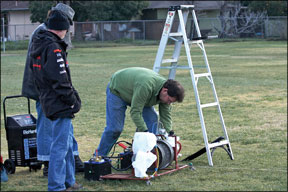
In contrast, my young Rat Terrier, Pretzel, started screaming her head off as soon as she saw and heard the racing. Lure coursing continues to be her favorite activity.
California dog owner Verial Whitten has experienced similar reactions even among her sighthounds. “My first Saluki, Giselle, began luring when she was four years old; we just didn’t try earlier and were surprised at how much fun it was for her. I have had four other Salukis since, with Reah being the latest; she absolutely loves it and is doing quite well. Rikah would never run the lure, Eliana ran for her Junior Courser title but would not run in competition with other dogs, and Kai, my 16-month-old puppy is not agile enough yet to start.”
Test your dog. Get an old horse whip (this is a better use for it, anyway), tie a piece of fake sheepskin or other fleecy material on the end, and drag it around the yard, making it leap and dart like prey. Did your dog go “ho-hum”? Or did his eyes dilate, his body burst into motion, and his activity continue until he caught and pounced on his prize? The latter is the dog who will probably enjoy lure coursing.
Lure Course Handler Attributes
This sport does not require a lot of physical activity from handlers. The start-line set up requires you to be able to hold back your dog from breaking away early so this can place some wear and tear on aging backs. And you may have to dart around a bit to get your dog back on leash at the finish, but this is a sport that does not put undue physical stress on handlers.
Lure Coursing Equipment and Supplies
Very little gear is needed to practice lure coursing:
Rewards – Tug toys and fleecy material on a rope work well in training young pups to chase a lure. Most dogs who really love lure coursing are motivated by reaching the lure, so treats are not typically used in this sport.
Miscellaneous supplies – Collar and leash, crate or exercise pen, water bowl, ice chest for your drinks, a chair, and a canopy to shade you and your dog are all you need for recreational lure coursing.
If you plan to compete, you will also need coursing blankets and a coursing slip lead. Coursing blankets come in three different colors: hot pink, bright yellow, and cyan blue. They are very light-weight and form a shell around the dog’s shoulders, chest, and ribs. They are used by the judge and handlers to distinguish the dogs from each other; it’s difficult to pick out your dog from the others when they are running at a great distance from you!
The collar or neck piece of a coursing slip lead is very wide and padded so that a dog who strains against it doesn’t gasp for air. A coursing slip lead also allows the handler to instantly release the leash so the dog can get a fast start.
Coursing blankets and slip leads are widely available online by searching for “lure coursing blankets”or “lure coursing slip leads.” One good source is Deborah Butler’s Sighthound Gear (sighthoundgear.com; 515-352-3659). Some clubs provide loaner blankets and leads to competitors, and some competitors make their own.
Lure Coursing Expenses
This is a relatively inexpensive sport since most people practice with clubs that provide the pulley system. The biggest expense is travel to the events.
Lure Course Training
This sport works best for dogs with an instinct to chase. Not much training is required. In fact, if you choose not to compete, no training is required. Just go out and get your dog on the start line and let go!
Levels of Competition
Dogs must be at least one year of age and certified as an acceptable breed with the sponsoring organization before entering a trial. Local breed clubs host trials sanctioned by one of these sponsoring groups.
It’s best to visit these organization’s websites to learn more about their specific titling requirements. There are significant differences in the titles available.
An example of how judges score each run is found in Section 7 of the AKC’s regulations. Scoring begins from the time the dog enters the field to the time he leaves the field with his handler. A total of 50 points are available, with 10 points possible in each category: overall ability, following (as opposed to short-cutting across the field), speed, agility, and endurance.
Jim Wallace
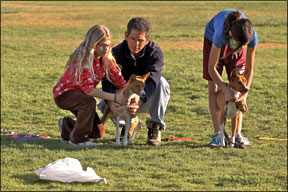
Generally, dogs compete against other dogs of their own breed, as well as against other breeds. The only dog that is not allowed to compete against other dogs is the Italian Greyhound which, due to its size and speed, might be mistaken for prey by the larger sighthounds. Novice dogs race alone; they must earn eligibility to compete stride by stride with other dogs by running alongside a “testing hound” without losing enthusiasm for coursing the lure – and without coursing the testing hound! Interfering with the other dog, playfully or aggressively, is cause for disqualification.
How to Get Started
Most people who want to compete with their sighthounds join a local breed club to train and practice. You can locate clubs by going to the ASFA or AKC websites.
If you do not have a sighthound that can be certified by one of the sponsoring organizations, contact one of the recreational coursing organizations. Also keep your ears open for large, multiple-sport, or fundraiser events in your area. Sometimes they host lure coursing as an added feature. It will be worth the drive just to watch the variety of dogs who love this game, and you can give your dog a try at it.
Is Lure Coursing for You?
If your dog loves to chase things, this sport is probably for you. Give it a try, and you’ll probably be hooked, and so will your dog. Saluki owner Whitten says it best. “Reah loves lure coursing. When she is fulfilling the natural desire to course game, she puts her heritage to work and just to see her smiling is worth it. While there is some subjectivity in scoring, there seems to be less ‘politics’ as might be in conformation showing. It also gets us out in the fresh air around some very nice people. It would be nice to see more venues available for all dogs. My Labrador was a maniac for the lure!”
As usual, have fun, train positively, and revel in the relationship with your dog, not the ribbons on the wall.
Author Terry Long would like to thank the San Diego Rhodesian Ridgeback Club, photographer Jim Wallace, and Verial Whitten for sharing their time, knowledge, and enthusiasm about lure coursing.
Terry Long, CPDT, is a writer, agility instructor, and behavior counselor in Long Beach, California.



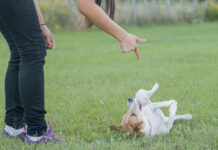
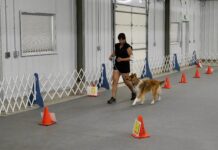
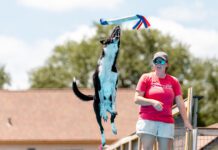

two questions. one, my dog gets so amped up screaming and choking himself out prior to coursing, is this preventable? Dangerous? Also, can he inhale pieces of the lure plastic if he rips some off, and if so what will happen? what do I do? and can I prevent it? in coursing he doesn’t usually run muzzled as he is really breathing hard and the muzzle seems to interfere with breathing on the full course. Thank you
Hello! I came across Lure Coursing and I thought of my Dobie. She has an extremely high prey drive and I am wondering if this would be good for a dog with a high prey drive.